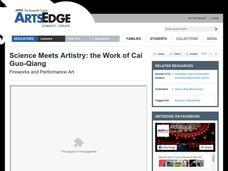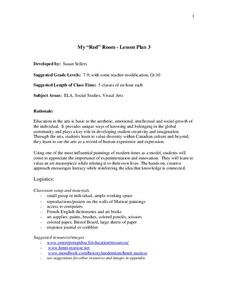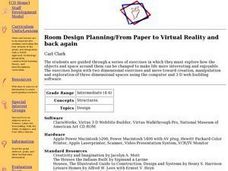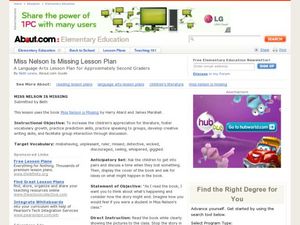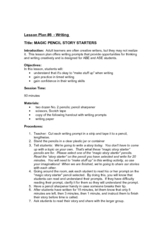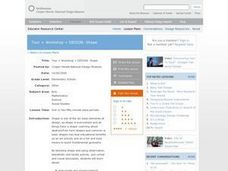Curated OER
A unicorn in the Snow
First graders compose own poetic sentences, using repetitive patterns, and carefully select sentenes with imagery. They make connections and see relationships and envision what might be. The poem is to be about an unexpected snowfall...
Curated OER
Science Meets Artistry: the Work of Cai Guo-Qiang
Students discuss and examine the work of artist Cai Guo-Qiang. In this art lesson, students analyze how cultural and historical factors impact the visual arts.
Curated OER
Represent Yourself
Students reflect on their strengths, to foster postive self-awareness and self-esteem. They discuss what the purpose of an adertisement is. What can an ad communicate? Students create an ad of themselves that reflects their own...
Curated OER
My "Red" Room
Students utilize art analysis skills by examining the work of Henri Matisse. In this painting lesson, students examine L'Atelier Rouge by Henri Matisse and identify the objects in the room and colors used. Students create their own rough...
Curated OER
The Envelope Please
Students examine and research the importance and functions of the skeletal system in vertebrates. They construct a 10-foot geodesic dome to illustrate the importance of architectural frameworks and create a clay animation movie.
Curated OER
Youth and Children
Students investigate the rights that students possess while examining human rights in relation to bullying. They develop ideas and advice for conflict resolution between students.
Curated OER
Room Design Planning/From Paper to Virtual Reality and Back Again
Students participate in activities in which they explore how the space and objects around them can be altered. Using various types of software, they design and create a three-dimensional building and share it with the class. They also...
Curated OER
A Sample Mini-lesson for Teaching Writing Conventions
Students study writing conventions. In this writing conventions lesson plan, students study writing they have already completed and look for conventions they are already using without realizing. In a small group, students discuss...
Curated OER
Show Me a Flowerpot
Students compare and contrast handmade and machine-made products in a study about the evolution of production processes in American history. In this production history instructional activity, students explore a flowerpot in depth....
Curated OER
Moving Objects
Students discover the history of the United States by examining the Great Migration. In this U.S. History lesson, students research the immigration movement on the Internet and complete a worksheet about the large population shift. ...
Curated OER
Track Traces
Students explore animal characteristics by participating in an animal anatomy activity. In this animal tracks lesson, students identify the differences between specific animals and the shape of their footprints. Students utilize a...
Curated OER
Fairy Tales Unit Ideas
Learners listen to children's fairy tales and watch them on a video. Afterward, they list the heroes from each story. Students write a short paragraph about a typical day for the hero. Learners dress up like their character and give a...
Curated OER
What Does Art Sound Like?
Help your charges investigate visual art by identifying sounds that are associated with the images. They view art galleries online and discuss which sounds would be present if the image was a real life situation. Additionally, they...
Curated OER
Travel to Europe
Students work in small groups to plan an imaginary trip to Europe, including Germany. They research travel routes, prices and popular sights of each destination. Students assemble a booklet describing their itinerary, budget, packing...
Curated OER
Miss Nelson is Missing Lesson Plan
Second graders listen to the story Miss Nelson is Missing by Harry Allard and James Marshall. In this literature lesson plan, 2nd graders predict the story's ending with drawings and discussions within groups.
Curated OER
The Heart of the Matter
Upper elementary pupils learn about the blood transportation system and anatomy of the human heart. They fill in an outline of the human heart (not included) focusing on the flow of blood to and from the heart. Using stethoscopes, they...
Curated OER
We All Live Together
First graders examine the lifestyle of classroom and family pets in their natural habitat. They determine the needs of plants and animals, and how those needs are met. They listen to read alouds, sing songs, and draw using computer based...
Curated OER
A Day in the life of...
Young scholars read about and study insects--their distinguishing characteristics, habitats, camouflage methods, defense mechanisms, etc. They draw pictures and write a story from the viewpoint of an insect and share their pictures and...
Curated OER
Magic Pencil Story Starters
While mentioning adult learners in the description, this lesson could be used at any grade level. This activity gives a list of procedures and writing prompts to help unlock the writer in everyone. Learners of all ages could benefit from...
Curated OER
What to do Between AP Exams and Semester Finals
Trying to write your end-of-year exam while encouraging scholars to begin reviewing? Do both using this study-skills strategy, which has scholars writing their own test! Although this lesson is intended for AP classes, it is applicable...
Curated OER
Environmental Fair
Students find a piece of trash and make a useful item out of it. They show awareness of the environmental concerns of the earth.
Curated OER
Clay Gargoyles and Grotesques
Grotesques or gargoyles are wonderful subjects for stories or art projects. Here is a simple "how to" for creating a lesson about sculpting clay gargoyles. Tip: Have learners research gargoyles throughout history.
Curated OER
Fire Brigade
Students examine how a community works together to protect them from fire. They work together to design a functional tool that could be helpful in fighting fires. They share their tool with the class.
Curated OER
Tour + Workshop = DESIGN: Shape
Ask elementary students to explore shapes in everyday objects. They will discuss the elements of design and describe the shapes they see in visual images. Students will then design and "build" a new 3D shape. Finally they will show and...



